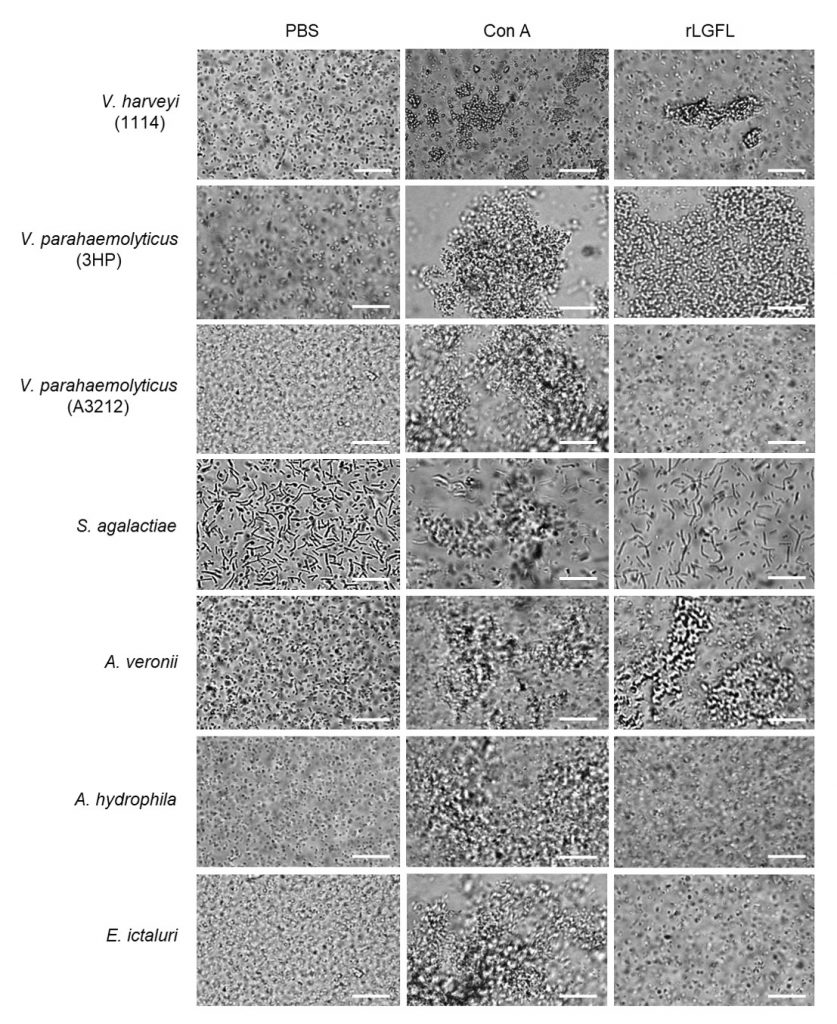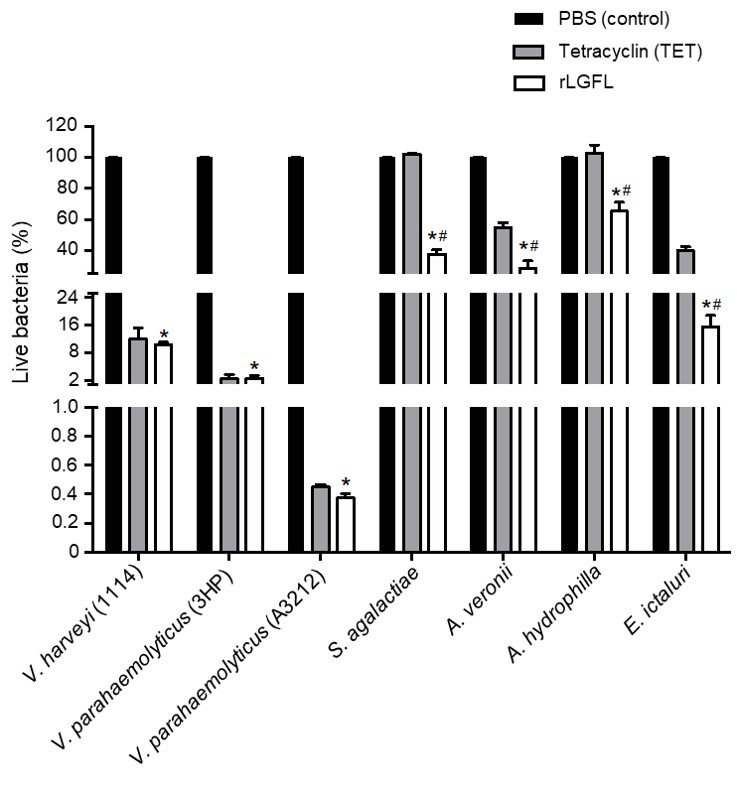

Highlight
เลคตินชนิด L ที่ผลิตแบบรีคอมบิแนนต์จากสาหร่ายแดง Gracilaria fisheri แสดงฤทธิ์ในการรวมตัวของเซลล์เม็ดเลือดแดงและต้านเชื้อแบคทีเรียหลายชนิดที่ก่อโรคในสัตว์น้ำ เช่นแบคทีเรียกลุ่ม Vibrio, Streptococcus และ Aeromonas ผลการวิจัยชี้ให้เห็นถึงศักยภาพของเลคตินในการพัฒนาเป็นสารต้านเชื้อจากธรรมชาติ เพื่อลดการใช้ยาปฏิชีวนะในอุตสาหกรรมเพาะเลี้ยงสัตว์น้ำ
ที่มาและความสำคัญ
เลคติน (Lectins) เป็นโปรตีนที่สามารถจับกับหมู่คาร์โบไฮเดรตบนผิวเซลล์ของจุลชีพได้อย่างจำเพาะ และมีบทบาทสำคัญในระบบภูมิคุ้มกันโดยธรรมชาติ เช่น การกระตุ้นการรวมตัวของเชื้อ การจับและกำจัดเชื้อโรคผ่านกลไกของภูมิคุ้มกัน ตลอดจนการยับยั้งการเจริญเติบโตของจุลชีพหลายชนิด เลคตินที่พบในสาหร่ายทะเล โดยเฉพาะสาหร่ายแดง มีความหลากหลายทั้งในด้านโครงสร้างและหน้าที่ และมีรายงานถึงฤทธิ์ทางชีวภาพที่น่าสนใจหลายประการ อย่างไรก็ตาม เลคตินจาก Gracilaria fisheri ยังไม่ได้รับการศึกษาทางหน้าที่อย่างเป็นระบบ งานวิจัยนี้จึงมีวัตถุประสงค์เพื่อผลิตและศึกษาลักษณะการทำงานของเลคตินชนิด L (L-type lectin) จาก Gracilaria fisheri โดยใช้เทคนิครีคอมบิแนนต์โปรตีนใน Escherichia coli และประเมินฤทธิ์ต้านเชื้อแบคทีเรียที่เกี่ยวข้องกับโรคในอุตสาหกรรมเพาะเลี้ยงสัตว์น้ำ สำหรับการพัฒนาเลคตินเป็นสารชีวภาพทางเลือกสำหรับการควบคุมโรคในระบบการเลี้ยงสัตว์น้ำอย่างยั่งยืนในอนาคต
Abstract
Marine algal lectins are promising bioactive compounds with antimicrobial potential. This study produced and characterized a recombinant legume-type lectin from Gracilaria fisheri (rLGFL) and evaluated its antibacterial activity. The LGFL gene was cloned, sequence-verified, and expressed in Escherichia coli. Western blot analysis using a mouse polyclonal antiserum confirmed rLGFL expression. Functional assays demonstrated strong hemagglutination against rabbit erythrocytes, indicating carbohydrate recognition domain (CRD) functionality. rLGFL agglutinated Vibrio parahaemolyticus (3HP), Vibrio harveyi (1114), and Aeromonas veronii while exhibiting bactericidal activity against all tested pathogens, including non-agglutinated V. parahaemolyticus (A3212), Streptococcus agalactiae, Aeromonas hydrophila, and Edwardsiella ictaluri. These findings suggest dual antibacterial mechanisms: agglutination-mediated pathogen immobilization and direct bactericidal effects. Seasonal analysis of G. fisheri from Songkhla, Thailand, revealed peak LGFL expression from January to March and July to September, identifying optimal harvesting periods. This study highlights rLGFL as a potential eco-friendly antibacterial agent with applications in aquaculture and disease management.
KEYWORDS: Gracilaria fisheri, Recombinant lectin, Bacterial agglutination, Bactericidal, Shrimp pathogens, Fish pathogens
Citation: Boonsri, B., Rudtanatip, T., Khunrare, P., Rattanarojpong, T., Withyachumnarnkul, B., & Wongprasert, K. (2025). Functional characterization of the recombinant L-type lectin from red alga Gracilaria fisheri with antibacterial potential. Algal Research, 104092.
https://doi.org/10.1016/j.algal.2025.104092
RELATED SDGs:
SDG Goal หลัก ที่เกี่ยวข้อง
2. Zero hunger

SDG Goal ที่เกี่ยวข้องอื่น ๆ
12. Responsible consumption production

ผู้ให้ข้อมูล: ศาสตราจารย์ ดร.กนกพรรณ วงศ์ประเสริฐ
ชื่ออาจารย์ที่ทำวิจัย: ศาสตราจารย์ ดร.กนกพรรณ วงศ์ประเสริฐ
แหล่งทุนวิจัย: Thailand Science Research and Innovation (TSRI) (Grant no. RGNS 65-199), Mahidol University (Fundamental Fund: fiscal year 2023 by National Science Research and Innovation Fund, Grant no. FF-056/2566).
Credit ภาพ: ศาสตราจารย์ ดร.กนกพรรณ วงศ์ประเสริฐ
Webmaster: ว่าที่ ร.อ. นเรศ จันทรังสิกุล
Tags: Bacterial agglutination, Bactericidal, Fish pathogens, Gracilaria fisheri, Recombinant lectin, Shrimp pathogens
